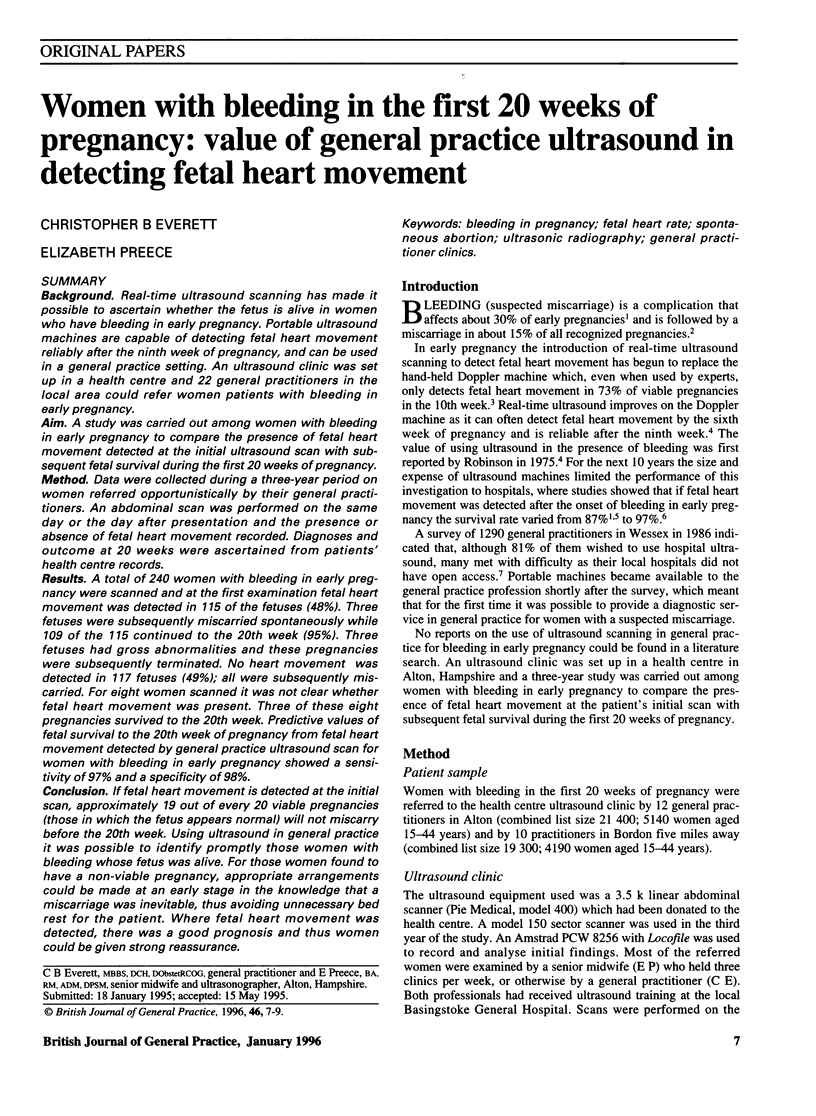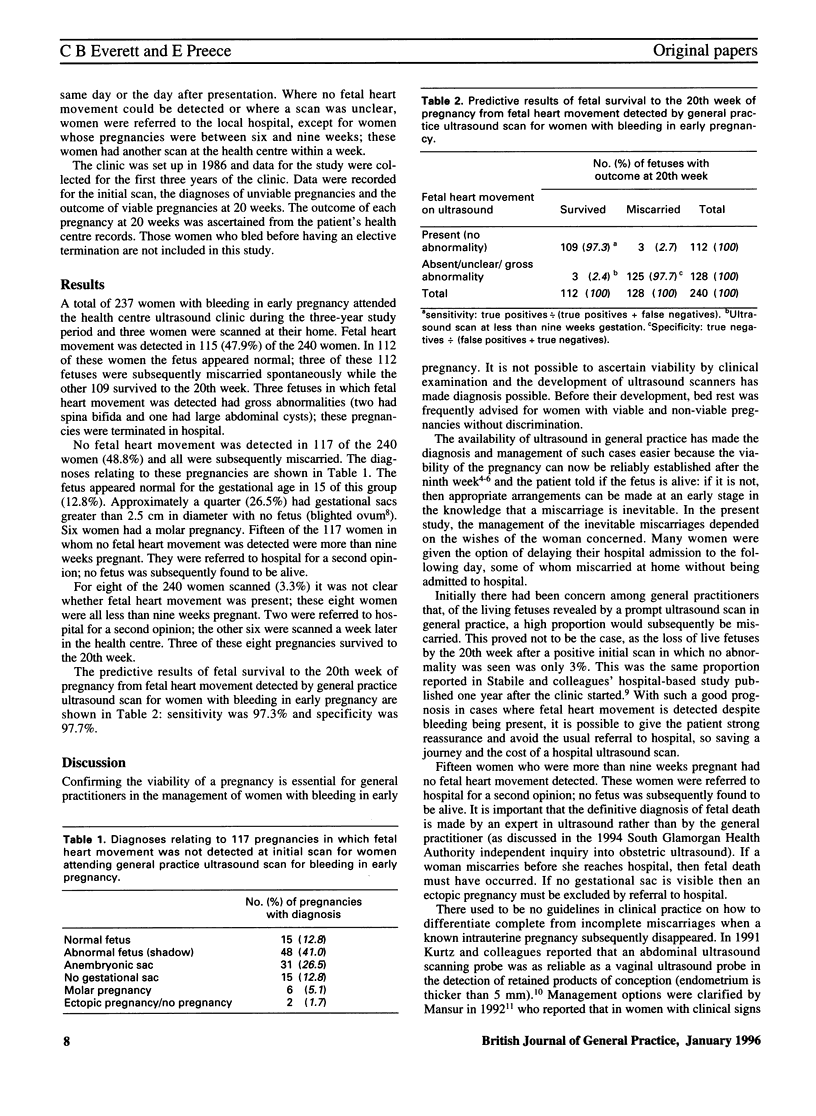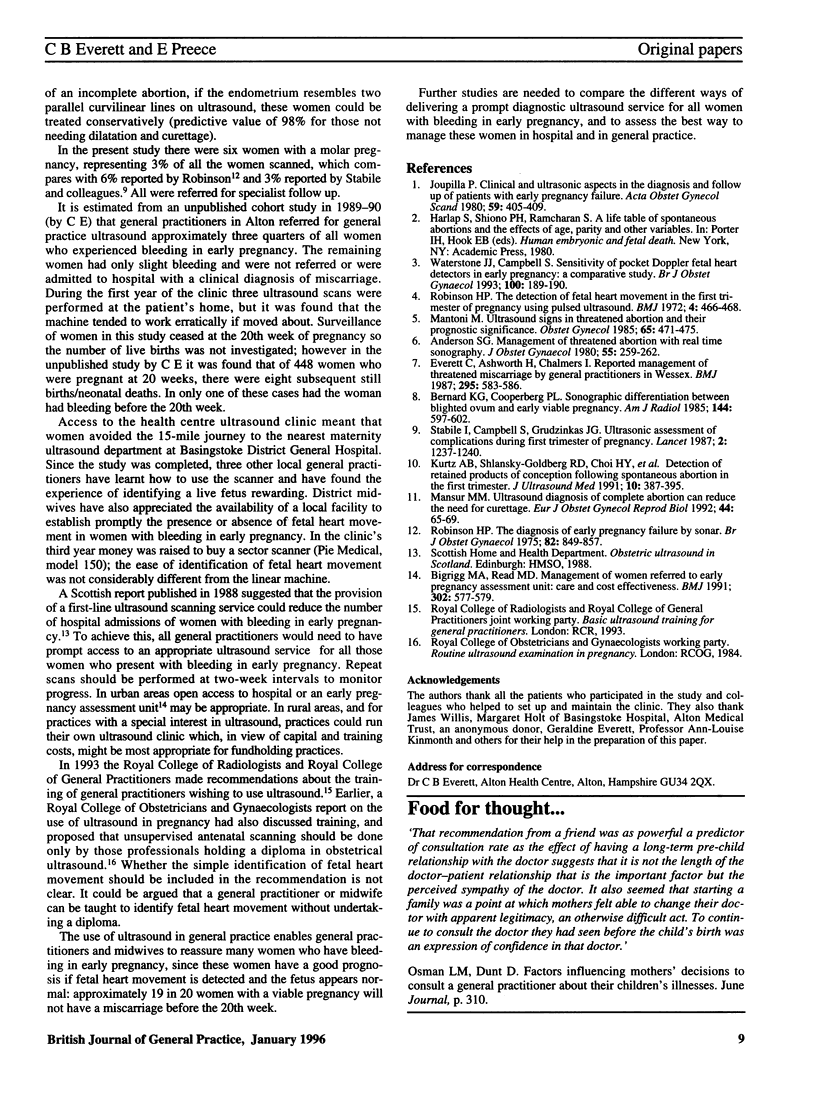Abstract
BACKGROUND: Real-time ultrasound scanning has made it possible to ascertain whether the fetus is alive in women who have bleeding in early pregnancy. Portable ultrasound machines are capable of detecting fetal heart movement reliably after the ninth week of pregnancy, and can be used in a general practice setting. An ultrasound clinic was set up in a health centre and 22 general practitioners in the local area could refer women patients with bleeding in early pregnancy. AIM: A study was carried out among women with bleeding in early pregnancy to compare the presence of fetal heart movement detected at the initial ultrasound scan with subsequent fetal survival during the first 20 weeks of pregnancy. METHOD: Data were collected during a three-year period on women referred opportunistically by their general practitioners. An abdominal scan was performed on the same day or the day after presentation and the presence or absence of fetal heart movement recorded. Diagnoses and outcome at 20 weeks were ascertained from patients' health centre records. RESULTS: A total of 240 women with bleeding in early pregnancy were scanned and at the first examination fetal heart movement was detected in 115 of the fetuses (48%). Three fetuses were subsequently miscarried spontaneously while 109 of the 115 continued to the 20th week (95%). Three fetuses had gross abnormalities and these pregnancies were subsequently terminated. No heart movement was detected in 117 fetuses (49%); all were subsequently miscarried. For eight women scanned it was not clear whether fetal heart movement was present. Three of these eight pregnancies survived to the 20th week. Predictive values of fetal survival to the 20th week of pregnancy from fetal heart movement detected by general practice ultrasound scan for women with bleeding in early pregnancy showed a sensitivity of 97% and a specificity of 98%. CONCLUSION: If fetal heart movement is detected at the initial scan, approximately 19 out of every 20 viable pregnancies (those in which the fetus appears normal) will not miscarry before the 20th week. Using ultrasound in general practice it was possible to identify promptly those women with bleeding whose fetus was alive. For those women found to have a non-viable pregnancy, appropriate arrangements could be made at an early stage in the knowledge that a miscarriage was inevitable, thus avoiding unnecessary bed rest for the patient. Where fetal heart movement was detected, there was a good prognosis and thus women could be given strong reassurance.
Full text
PDF


Selected References
These references are in PubMed. This may not be the complete list of references from this article.
- Anderson S. G. Management of threatened abortion with real-time sonography. Obstet Gynecol. 1980 Feb;55(2):259–262. [PubMed] [Google Scholar]
- Bernard K. G., Cooperberg P. L. Sonographic differentiation between blighted ovum and early viable pregnancy. AJR Am J Roentgenol. 1985 Mar;144(3):597–602. doi: 10.2214/ajr.144.3.597. [DOI] [PubMed] [Google Scholar]
- Bigrigg M. A., Read M. D. Management of women referred to early pregnancy assessment unit: care and cost effectiveness. BMJ. 1991 Mar 9;302(6776):577–579. doi: 10.1136/bmj.302.6776.577. [DOI] [PMC free article] [PubMed] [Google Scholar]
- Everett C., Ashurst H., Chalmers I. Reported management of threatened miscarriage by general practitioners in Wessex. Br Med J (Clin Res Ed) 1987 Sep 5;295(6598):583–586. doi: 10.1136/bmj.295.6598.583. [DOI] [PMC free article] [PubMed] [Google Scholar]
- Jouppila P. Clinical and ultrasonic aspects in the diagnosis and follow-up of patients with early pregnancy failure. Acta Obstet Gynecol Scand. 1980;59(5):405–409. doi: 10.3109/00016348009155418. [DOI] [PubMed] [Google Scholar]
- Kurtz A. B., Shlansky-Goldberg R. D., Choi H. Y., Needleman L., Wapner R. J., Goldberg B. B. Detection of retained products of conception following spontaneous abortion in the first trimester. J Ultrasound Med. 1991 Jul;10(7):387–395. doi: 10.7863/jum.1991.10.7.387. [DOI] [PubMed] [Google Scholar]
- Mansur M. M. Ultrasound diagnosis of complete abortion can reduce need for curettage. Eur J Obstet Gynecol Reprod Biol. 1992 Mar 23;44(1):65–69. doi: 10.1016/0028-2243(92)90315-p. [DOI] [PubMed] [Google Scholar]
- Mantoni M. Ultrasound signs in threatened abortion and their prognostic significance. Obstet Gynecol. 1985 Apr;65(4):471–475. [PubMed] [Google Scholar]
- Robinson H. P. Detection of fetal heart movement in first trimester of pregnancy using pulsed ultrasound. Br Med J. 1972 Nov 25;4(5838):466–468. doi: 10.1136/bmj.4.5838.466. [DOI] [PMC free article] [PubMed] [Google Scholar]
- Robinson H. P. The diagnosis of early pregnancy failure by sonar. Br J Obstet Gynaecol. 1975 Nov;82(11):849–857. doi: 10.1111/j.1471-0528.1975.tb00588.x. [DOI] [PubMed] [Google Scholar]
- Stabile I., Campbell S., Grudzinskas J. G. Ultrasonic assessment of complications during first trimester of pregnancy. Lancet. 1987 Nov 28;2(8570):1237–1240. doi: 10.1016/s0140-6736(87)91853-8. [DOI] [PubMed] [Google Scholar]
- Waterstone J. J., Campbell S. Sensitivity of pocket Doppler fetal heart detectors in early pregnancy: a comparative study. Br J Obstet Gynaecol. 1993 Feb;100(2):189–190. doi: 10.1111/j.1471-0528.1993.tb15222.x. [DOI] [PubMed] [Google Scholar]


